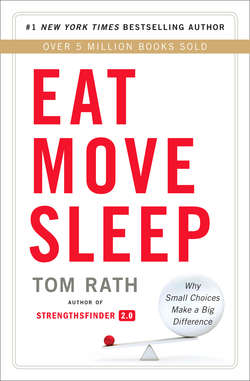Читать книгу Eat Move Sleep - Tom Rath - Страница 16
На сайте Литреса книга снята с продажи.
ОглавлениеArranging Your Day for More Energy
7
Be Less Refined
We are addicted to refined carbohydrates. One publication went as far as to describe carbs as “more addictive than cocaine” and concluded, “At the center of the obesity universe lies carbohydrates, not fat.” As a team of Harvard researchers wrote in the Journal of the American Medical Association, carbs are a “nutrient for which humans have no absolute requirement.” Another study suggests that eating fewer carbs even curbs cancer growth rates by as much as 50 percent.
Yet quitting refined carbs altogether would be an uphill climb. Most animals, humans include, have evolved to prefer the taste of carbohydrates over protein. Carbs also stimulate pleasurable dopamine centers in the brain. And they are cheap and convenient. Everywhere you turn, pasta, bread, chips, or a bowl of rice is staring you in the face. I guess this explains why it is still so hard for me to choose a salad over a sandwich.
Do everything you can to replace refined carbohydrates with vegetables when you prepare or order a meal. You get enough carbohydrates from fruits, vegetables, and protein. Try to reduce your consumption of pasta, bread, rice, and chips in particular. Most restaurants will let you substitute a vegetable for a side of rice, pasta, or fries. Keep most of the refined carbs from making it to your plate in the first place. That way you won’t need a superhuman amount of willpower to resist what is sitting in front of you during a meal.
Instead of chips, crackers, or bars, find natural snacks like nuts, carrots, apples, celery, kale chips, or seeds. Then avoid the processed and refined carbs at all costs. Remember, this is one case where “refined” does not mean “better” or “improved.”
Family Style Is Making Us Fat
When food is served “family style” from large plates, bowls, or platters placed in arms’ reach, people simply eat more. One study found that women eat about 10 percent more. Men move even faster through their first helping and eat an additional 29 percent if the dish is on the table instead of on the counter.
To avoid eating more food than you need, leave the serving plates in the kitchen, on a counter, or anywhere else that requires people to stand up and leave the table for another helping. This will allow your family and friends to be selective and take only what they really want. It should also keep them from eating too much and becoming uncomfortably full.
Once you move the serving plates off the table, you might notice that people are less likely to get up and grab seconds or thirds. Some people will remain seated just to avoid the perception of overeating. Others will stay seated simply because getting up requires effort. Either way, sit back and watch how you have channeled social pressure in a positive direction.
Also, when you cook for yourself or your immediate family and you make extra food to save for leftovers, put those portions away before you eat. If you leave the excess food sitting out, someone is bound to eat more than they had originally planned.
Burn Calories After Your Workout
While a few hours of activity a day sounds like a daunting challenge, it is not when you reverse the equation. If someone told you to avoid 23 hours of inactivity per day, I assume you would agree with this advice wholeheartedly. Yet without some deliberate effort, it is easy to spend 23 hours a day sitting, sleeping, and moving slowly.
Study your distribution of activity for one of your typical days. Start with the easy math and add up how much time you spend sitting each day. Do everything possible to reduce that number. Then focus on doing anything that gets your heart beating a little faster than normal.
Any workout will burn calories. However, as your level of intensity increases, you continue burning calories for many hours after your workout ends. New research suggests that vigorous activity could increase the total benefit of a workout by nearly 50 percent over the duration of an entire day. When participants in an experiment rode a stationary bicycle at high intensity for 45 minutes, the exercise itself burned about 420 calories. Yet what is most interesting is that over the next 14 hours, the participants burned 190 additional calories on average.
When you exercise, push yourself to the point where it would be hard to have a conversation. Or use a heart rate monitor to ensure you are in the right target zone. If you can get to this point for much of the workout, your body will continue to benefit for hours after you exercise.
Replace chips, crackers, and snack bars with nuts, seeds, apples, celery, and carrots.
Always leave the serving dishes in the kitchen; don’t bring them to the table.
Get a full hour of vigorous activity to burn calories all day long.
